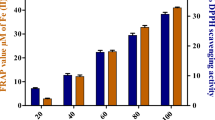Abstract
Parkinson’s disease (PD) is one of the most frequent disorders of the basal ganglia. From epidemiological studies there is a controversial discussion on the question whether tobacco smoking is correlated with a decreased incidence of PD. The present study aimed to elucidate the role of nicotine and its potential neuroprotective effects in a rodent model of PD. These effects may be related to an altered hydroxyl radical formation; this possibility was studied in vitro. Nicotine and α-phenyl-N-tert-butyl nitrone (PBN) were examined in a cell-free in vitro Fenton system (Fe3+/EDTA + H2O2) for their radical scavenging properties using the salicylate trapping method. Salicylic acid (0.5 mM) was incubated in the presence and absence of nicotine or PBN and the main products of the reaction of hydroxyl radicals with salicylic acid, namely 2,3- and 2,5-dihydroxybenzoic acid, were immediately determined using HPLC in combination with electrochemical detection. Nicotine and PBN were both able to significantly reduce hydroxyl radical levels at concentrations of 1, 2.5 and 5 mM. Interestingly, at 5 mM nicotine was able to reduce hydroxyl radical levels significantly more than the radical scavenger PBN (5 mM). To investigate the in vivo effects of nicotine, male C57BL/6 mice were used in the MPTP mouse model of PD. Nicotine (0.1 or 0.4 mg/kg s.c.) was administered twice daily for a period of 14 days. On day 8 a single injection of 1-methyl-4-phenyl-1,2,3,6-tetrahydropyridine (MPTP, 30 mg/kg s.c.) was given as well as an enhanced protocol of nicotine treatment (0.1 or 0.4 mg/kg s.c., 30 min before MPTP and 30, 90, 210, 330, 450, 570 min after MPTP) for a total of seven injections of nicotine. High dosage nicotine treatment significantly increased the MPTP-induced loss of body weight and resulted in a significantly decreased striatal dopamine content and an increased dopamine turnover in comparison with the MPTP-treated controls at day 15. However, the lower dosage of nicotine did not significantly alleviate the MPTP-induced effects, although some parameters showed a slight tendency in this direction. These results demonstrate that in vitro nicotine has radical scavenging properties which might suggest neuroprotective effects. In vivo experiments with nicotine, however, showed that a low dosage of nicotine did not alleviate the MPTP-induced dopamine depletion, but a large dosage even enhanced it.
Similar content being viewed by others
Author information
Authors and Affiliations
Additional information
Received: 20 March 1998 / Accepted: 23 June 1998
Rights and permissions
About this article
Cite this article
Ferger, B., Spratt, C., Earl, C. et al. Effects of nicotine on hydroxyl free radical formation in vitro and on MPTP-induced neurotoxicity in vivo. Naunyn-Schmiedeberg's Arch Pharmacol 358, 351–359 (1998). https://doi.org/10.1007/PL00005264
Issue Date:
DOI: https://doi.org/10.1007/PL00005264




